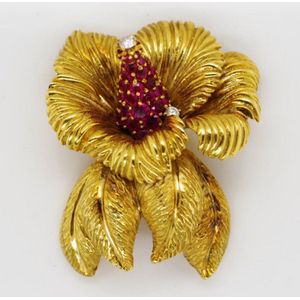Diamond Bar Brooch and Amber Bead Strand Set
You must be a subscriber, and be logged in to view price and dealer details.
Subscribe Now to view actual auction price for this item
When you subscribe, you have the option of setting the currency in which to display prices to $Au, $US, $NZ or Stg.
- Amber - More frequently used to refer to the colour, than the material from which the word is derived, amber is the fossilized resin from ancient forests. It is not produced from tree sap, but rather from plant resin. The resin is aromatic, and can drip from and ooze down trees. In colour, it may be a deep honey colour, (amber), brown, or white. As it oozes out it fills internal fissures in the tree, trapping debris such as seeds, leaves, feathers and insects. The debris trapped within the amber can assist in dating the deposit.
In its natural state it is found in rocks, on the sea floor (from where it may be washed up to the shore) and mined, using both open cut and underground techniques. About 90% of the world's amber comes from Russia. Amber has recently been discovered at Cape York in Northern Australia
Amber is often incorporated in jewellery, and used in pipe stems. The shine on the surface of amber becomes even more intense when it is worn and used regularly. Genuine amber, when rubbed, will release a slightly musky scent. - Circa - A Latin term meaning 'about', often used in the antique trade to give an approximate date for the piece, usually considered to be five years on either side of the circa year. Thus, circa 1900 means the piece was made about 1900, probably between 1895 and 1905. The expression is sometimes abbreviated to c.1900.
- Marcasite - Marcasite is a mineral, iron sulphide, but is rarely used in jewellery. Instead marcasite is the name given to iron pyrites, the mineral sold as marcasite which is identical in copmosition to iron sulphide but crystalises as a cube, making it more suitable for jewellery. It is a brassy yellow in colour and is also known as "fool's gold", and sits well with silver rather than gold becasue of its colour.
Marcasite has been used in jewellery since ancient times and became popular again in jewellery in the 18th century, continuing through to the early 20th century, with the settings becoming cheaper as time progressed, eventually earning the sobriquet "costume jewellery" along with other cheap jewellery that was made for a prevailing pattern and meant to be changed with each new outfit. - Sterling Silver - Sterling silver is a mixture of 92.5% pure silver and 7.5% of another metal, usually copper. Fine silver is 99.9% pure silver, and is relatively soft and the addition of the very small amount of copper gives the metal enough strength and hardness to be worked into jewellery, decorative and household objects.
This item has been included into following indexes:
- necklaces, gold - gold with diamonds 2,054
- necklaces, pearl - pearl, Baroque 323
-
necklaces, set with
- amber beads 414
- marcasite 74
Visually similar items

A pair of mother of pearl and emerald earrings, each comprising a finely carved mother of pearl flower centred with a carved emerald, mounted in 14ct gold. Condition: earrings present in excellent condition and stones are all well matched, having post and

Ruby brooch, 18ct yellow gold, multi-petal flower design with a central white gold setting containing twenty rubies. Weight 19 grams

A gold & ruby flower brooch 18 ct gold, with moveable petals and sixteem round rubies total weight 25gm

18ct gold ruby and diamond flower brooch, a gold arum calla flower form brooch with a ruby and diamond set centre. approx 2 x round brilliant cut diamonds & 46 RBC rubies. Total weight 27gms
